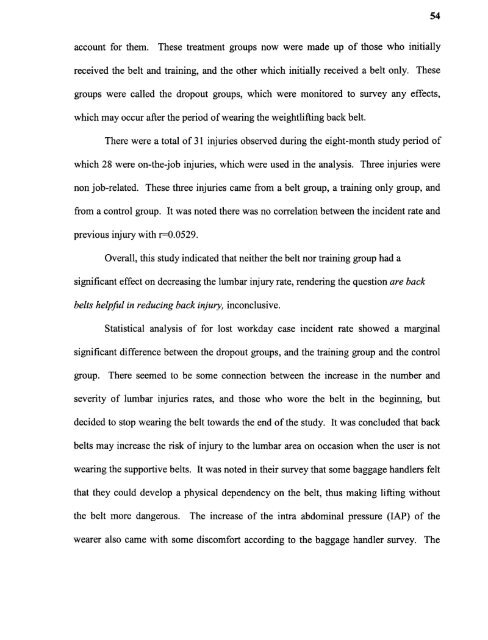An ergonomic assessment of the airline baggage handler
An ergonomic assessment of the airline baggage handler
An ergonomic assessment of the airline baggage handler
You also want an ePaper? Increase the reach of your titles
YUMPU automatically turns print PDFs into web optimized ePapers that Google loves.
54account for <strong>the</strong>m. These treatment groups now were made up <strong>of</strong> those who initiallyreceived <strong>the</strong> belt and training, and <strong>the</strong> o<strong>the</strong>r which initially received a belt only. Thesegroups were called <strong>the</strong> dropout groups, which were monitored to survey any effects,which may occur after <strong>the</strong> period <strong>of</strong> wearing <strong>the</strong> weightlifting back belt.There were a total <strong>of</strong> 31 injuries observed during <strong>the</strong> eight-month study period <strong>of</strong>which 28 were on-<strong>the</strong>-job injuries, which were used in <strong>the</strong> analysis. Three injuries werenon job-related. These three injuries came from a belt group, a training only group, andfrom a control group. It was noted <strong>the</strong>re was no correlation between <strong>the</strong> incident rate andprevious injury with r=0.0529.Overall, this study indicated that nei<strong>the</strong>r <strong>the</strong> belt nor training group had asignificant effect on decreasing <strong>the</strong> lumbar injury rate, rendering <strong>the</strong> question are backbelts helpful in reducing back injury, inconclusive.Statistical analysis <strong>of</strong> for lost workday case incident rate showed a marginalsignificant difference between <strong>the</strong> dropout groups, and <strong>the</strong> training group and <strong>the</strong> controlgroup. There seemed to be some connection between <strong>the</strong> increase in <strong>the</strong> number andseverity <strong>of</strong> lumbar injuries rates, and those who wore <strong>the</strong> belt in <strong>the</strong> beginning, butdecided to stop wearing <strong>the</strong> belt towards <strong>the</strong> end <strong>of</strong> <strong>the</strong> study. It was concluded that backbelts may increase <strong>the</strong> risk <strong>of</strong> injury to <strong>the</strong> lumbar area on occasion when <strong>the</strong> user is notwearing <strong>the</strong> supportive belts. It was noted in <strong>the</strong>ir survey that some <strong>baggage</strong> <strong>handler</strong>s feltthat <strong>the</strong>y could develop a physical dependency on <strong>the</strong> belt, thus making lifting without<strong>the</strong> belt more dangerous. The increase <strong>of</strong> <strong>the</strong> intra abdominal pressure (lAP) <strong>of</strong> <strong>the</strong>wearer also came with some discomfort according to <strong>the</strong> <strong>baggage</strong> <strong>handler</strong> survey. The
















